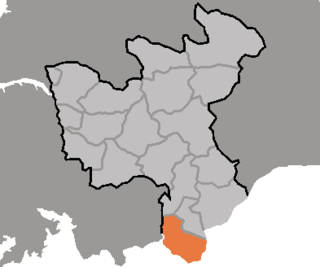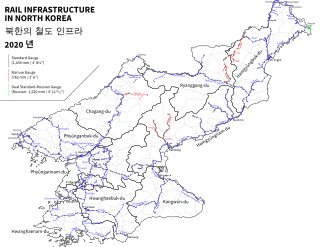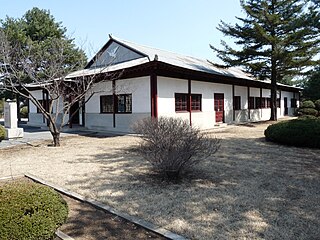
Tŏkch'ŏn is a si, or city, in northern South P'yŏngan province, North Korea. It is bordered by Nyŏngwŏn and Maengsan to the east, Kujang county in North P'yŏngan province to the north, Kaech'ŏn to the west and Pukch'ang to the south. It was known as Tokugawa during Japanese rule.

South Pyongan Province is a province of North Korea. The province was formed in 1896 from the southern half of the former Pyongan Province, remained a province of Korea until 1945, then became a province of North Korea. Its capital is Pyongsong.

South Hamgyong Province is a province of North Korea. The province was formed in 1896 from the southern half of the former Hamgyong Province, remained a province of Korea until 1945, then became a province of North Korea. Its capital is Hamhung.

Wiwŏn County is a kun, or county, in northern Chagang province, North Korea. It stands across the Yalu River from the People's Republic of China. It was originally part of North P'yŏngan province, but was annexed to Chagang in 1954. It borders Manp'o and Sijungto the north, Kanggye and Songgan to the east, Ch'onch'ŏn to the southeast, Kop'ung to the south and west, and Ch'osan to the west.

Ch'ŏnma County is a kun, or county, in northwestern North P'yŏngan province, North Korea. It borders Kusŏng city and Taegwan county to the east, Sonch'ŏn and Tongrim counties to the south, Ŭiju and P'ihyŏn counties to the west, and Sakchu county to the north. It was created in 1952 from parts of Kusŏng and Ŭiju.

Kujang County is a kun, or county, in southeastern North P'yŏngan province, North Korea. It was created in 1952 from part of Nyŏngbyŏn county, as part of a nationwide reorganization of local government. It borders Nyŏngbyŏn on the west, Hyangsan and Unsan counties on the north, Nyŏngwŏn on the east, and Kaech'ŏn and Tŏkch'ŏn cities to the south.

Pakch'ŏn County is a kun, or county, in southern North P'yŏngan province, North Korea. It is bordered to the north by T'aech'ŏn, to the east and southeast by Nyŏngbyŏn, and to the west by Unjŏn counties. To the south, it looks across the Ch'ŏngch'ŏn River at Anju city and Mundŏk county in South P'yŏngan province. In 1952, 4 myŏn of Pakch'ŏn were split off to join Unjŏn county; since then, the county's administrative divisions have been revised in 1954, 1956, 1958, 1978, 1980, and 1982.

T'aechŏn County or Thaechŏn County is a kun, or county, in central North P'yŏngan province, North Korea. It borders Taegwan and Tongch'ang to the north, Unsan and Nyŏngbyŏn to the east, Pakch'ŏn and Unjŏn to the south, and Kusŏng to the west.

Unsan County is a kun, or county, in eastern North P'yŏngan province, North Korea. Within the province, it borders Hyangsan in the east, Kujang and Nyŏngbyŏn in the south, and Tongch'ang and T'aech'ŏn in the west. In addition, it is bordered by Chagang province to the east (Hŭich'ŏn) and north (Songwŏn).

The following outline is provided as an overview of and topical guide to North Korea:

Kaep'ung-guyŏk is a ward in Kaesong, North Korea. Formerly part of the Kaesong urban area, the county was merged with North Hwanghae when Kaesong was demoted in 2003. However, it was returned to Kaesong Special City in October 2019.

North Korea has a railway system consisting of an extensive network of standard-gauge lines and a smaller network of 762 mm (30.0 in) narrow-gauge lines; the latter are to be found around the country, but the most important lines are in the northern part of the country. All railways in North Korea are operated by the state-owned Korean State Railway.
Ch'ŏngjin Ch'ŏngnyŏn station is the central railway station in Ch'ŏngjin-si, North Hamgyŏng Province, North Korea. It is the junction point of the Hambuk Line and the P'yŏngra Line of the Korean State Railway, and is the beginning of the Ch'ŏngjinhang Line to Ch'ŏngjin Port.

The Manp'o Line is an electrified standard-gauge trunk line of the North Korean State Railway running from Sunch'ŏn on the P'yŏngra Line to Manp'o on the Pukpu Line. The line continues on from Manp'o to Ji'an, China.

The Hambuk Line is an electrified standard-gauge trunk line of the Korean State Railway in North Korea, running from Ch'ŏngjin) on the P'yŏngra Line to Rajin, likewise on the P'yŏngra line.

The P'yŏngra Line is an electrified standard-gauge trunk line of the Korean State Railway in North Korea, running from P'yŏngyang to Rason, where it connects with the Hambuk Line. It is North Korea's main northeast–southwest rail line.
The 1995 municipal annexation in South Korea was an administrative event in which many cities and counties joined together into "urban-rural integrated" (도농복합시) cities as of 1 January 1995. Some of the annexation were done later as of 10 May 1995. Some of the counties were annexed to certain metropolitan cities(광역시) as of 1 March 2015.

Hoeryŏng Ch'ŏngnyŏn station is a railway station in Hoeryŏng-si, North Hamgyŏng, North Korea, on the Hambuk Line of the Korean State Railway. It is also the starting point of the 10.6-km-long freight-only Hoeryŏng Colliery Line to Yusŏn-dong, Hoeryŏng-si.

P'anmun-guyŏk is a ward in Kaesong, North Korea.

















